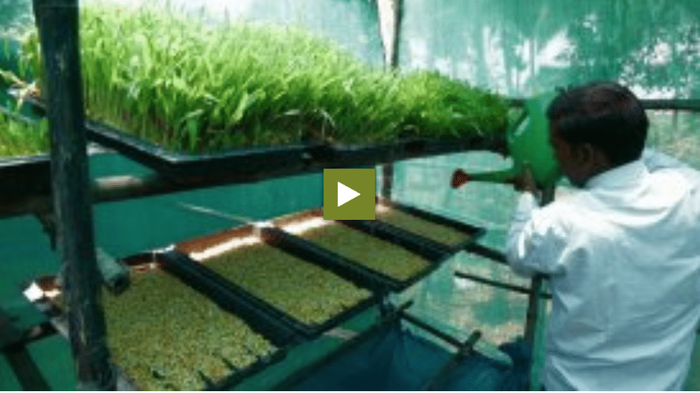You can cultivate hydroponic fodder without soil in little space. The hydroponic fodder can be produced all over the year, even in the dry season.
A difficulty of green fodder is, that often there isn‘t enough land and water to cultivate it. Furthermore, it is difficult to produce fodder around the year. Hydroponic fodder is a animal feed which is growing without seeds and with only a little use of water. One week after the seeds are sprouted, the seedlings are already about 30 centimetres big.
Growing Hydroponic fodder
Hydroponic fodder grows best in indirect sunlight. Therefore, you should build a shed or use a part of the animals shed. It is important to leave a little space between the walls and the roof of the shed to give ventilation. Hydroponic fodder grows on trays which are about half a metre long and can be transported easily. The trays should be strong enough to stand the weight of the fodder. Therefore, on one of these trays you can grow 1 kilogram of maize seeds. Plastic trays are more suitable then metal ones, because metal can rust. Make little holes in the trays, so that unnecessary water can run off. You should also build a bamboo rack, which holds the trays. Make sure that the sides of the rack fall away a little, so that water has another way to drain off.
You can use maize, wheat and pulses to produce fodder. Broken and unhealthy seeds should always be removed. Add one bucket of clean, lukewarm water in a tub with seeds. Then remove the seeds that are not floating on top, because these ones do not germinate. To prevent moulds, take half a handful of salt and let the seeds drawn in it for about 12 hours. Remove the sprouted seeds from the gunny bags and spread them evenly on the trays. Then lay the trays on your bamboo rack. When it is hot water the sprouted seeds every two hours a day, and when it is cold every 3 hours.
Make sure the shed always stays dry and clean so that moulds cannot develop. Furthermore, you should not take the sprouted seeds from the trays, to not destroy them.
Within a week one kilogram of maize seeds produce about 8 kilogram of fodder. Remove the trays and chop the slab of fodder in pieces. Then you can give your animals half hydroponic fodder and half dry fodder for feed.



















